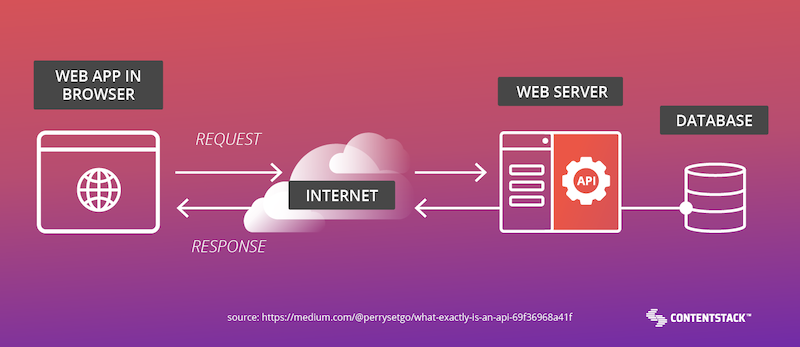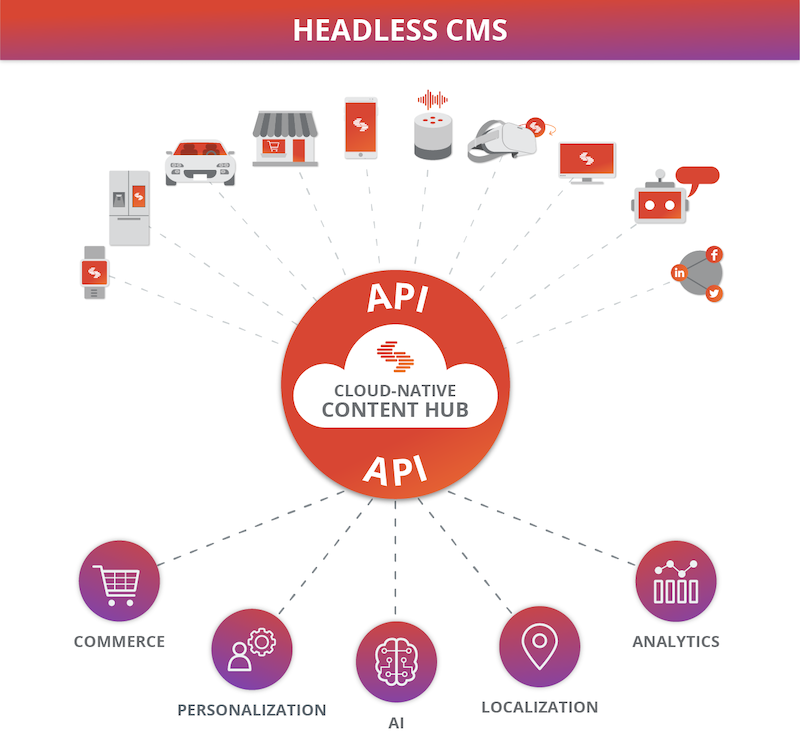Headless API: Your key to seamless content delivery

Explore how headless APIs can change your business model. Headless APIs deliver unrivaled flexibility, customization and fast omnichannel content delivery. Sign up for a free demo today to increase your content management efficiency and customer experience.
Highlights
You’ll learn how headless APIs:
- Enhance scalability and independence in your front-end development.
- Guarantee consistent, impactful content delivery across various devices.
- Facilitate large-scale content personalization.
- Integrate seamlessly with multiple platforms and devices.
- Regularly monitor and maintain to ensure optimum performance and security.
- Iterative improvements based on user feedback are important for API development.
Experience the transformation with a headless API. Make it a part of your content delivery today.
Keep reading to learn more!
Today, cut-throat competition exists among businesses and online stores; innovation, agility, and efficiency set you apart. One of the tools that perfectly reflects these qualities and is changing how businesses work is 'Headless API.'
This blog explores what a headless API is, explains its benefits, and discovers how to implement it.
What is a headless API?
A headless API or application programming interface helps developers interact with an application’s back-end services without any predefined user interface. Developers prefer a headless API because it promotes flexibility and innovations by decoupling the front and back-end components. The API offers the necessary raw data and functionality, helping developers to use any front-end tool or platform to display the data.
In contrast, traditional architecture tightly couples these components. By using different front-end frameworks and various back-end technologies, developers can offer personalized experiences across multiple platforms.
The headless API architecture integrates platforms such as websites, IoT apps, and mobile apps. Flexibility and scalability are promoted with a headless application programming interface.
How does a headless API work?
A headless API decouples the content repository (the "body") from the presentation layer (the "head"). It uses a series of API requests, allowing the front end to fetch and display content without facing limitations by the backend's business logic or structure.

When an API request is made from the front end, the headless API fetches the data from the back end's content management system (CMS) and delivers it in a raw, unstyled format, usually JSON or XML.
The front-end developers use this data to create a custom user interface suited for the particular channel (website, mobile application, or even an IoT device). The API-centric approach means the same back end can serve multiple front ends.
How does a headless API differ from a traditional API?
A headless API separates the content and presentation. The data is independent of how it’s displayed or used. This allows developers to present the same content across multiple platforms or channels with different presentations.
In contrast, traditional APIs tightly couple the data with its presentation.

Headless APIs provide more flexibility for developers. They can create any type of front-end experience without facing limitations from the back-end system. The API serves as a bridge between the data and the user interface. In contrast, traditional APIs often have certain constraints related to the technology stack used.
Fast-track digital experiences with Contentstack. Need to create digital experiences quickly? Contentstack's content and editorial engine enables you to reach new markets and create digital experiences faster. Manage content with ease and speed. Start your free trial today.
Benefits of using a headless API
Increases content management efficiency
The separation of presentation and content layers increases content management efficiency. It shows marketers and content managers how to change or repurpose content without a developer’s help. This helps you make quicker content updates, enhancing your business agility.
The decoupling gives you control over the changing market trends and customer demands, ensuring your business remains competitive. Headless content management systems reduce resource wastage and produce quality content.
Let’s understand how Contentstack’s headless CMS helped Elastic in content management:
Elastic faced challenges with its WordPress CMS. The CMS was clumsy, and they depended on a web agency for content management. Elastic turned to Contentstack for a solution that proved intuitive, efficient, and cost-effective.
By migrating to Contentstack, Elastic reduced costs by 78%. They streamlined their content management process, allowing for faster updates and multiple redesigns. Elastic has more than doubled the page views at a fraction of the cost.
After using the headless CMS, Sylvie Shimizu, Webmaster at Elastic, said:
"Contentstack scales to meet our needs. As we localize and add sub-domains for new regions, we can rely on the system to grow with us, no matter how big our site becomes. Contentstack provides us with peace of mind through both its technology and its team of highly experienced and responsive MS experts."
Read the entire case study here.
Makes your front end more scalable and independent
The headless application programming interface empowers you to choose suitable technologies for front-end development. With a headless approach, you create personalized user interfaces aligning with your branding goals. Developers scale both the front and back end independently based on the business requirements.
Ensures impactful content delivery
Headless architecture, like a headless CMS, goes beyond making your company more agile. Companies using this approach provide impactful content delivery that resonates with your target audience.
As your presentation layer is separate from the content repository, content editors and marketers ensure their message is consistent and adaptive across mobile devices, web browsers, and IoT devices.
Provides content personalization
Companies using a headless architecture facilitate content personalization at scale. You enhance engagement and conversion rates by delivering relevant and tailored content to your target audience.

With headless APIs, you establish strong connections with your users, providing a personalized digital experience that drives customer satisfaction and loyalty.
Offers integration with different platforms and devices
Headless APIs give your developers access to various functionalities across multiple platforms. Whether web browsers, mobile apps, or IoT devices, you reach users on their preferred channels.
Contentstack: A Leader in CMS Performance. Experience the strength of Contentstack, a standout performer in Forrester's Q3 2023 CMS report. Contentstack simplifies your digital experience with our back-end extensibility and global deployments. Request a demo to learn more.
Implementing headless APIs
Define the purpose of your API
Before you start developing an API, identifying your API’s purpose is essential. Answer these questions to know your purpose:
- Is it for internal use, or will it be public?
- Will it need to handle large volumes of data or smaller, more specific data sets?
Design your API
Next, design your API with customer experience in mind. Emphasizing these elements provides developers with a smooth experience, improving adoption and satisfaction rates. Remember to document your API by providing clear instructions and examples to guide your developers in using its functionality.
Choose a framework
Choose an API framework that aligns with your technology stack and supports the development of headless APIs. Some popular choices include Express.js for Node.js, Django for Python, and Rails for Ruby.
Develop your API
When developing your API, the first step is choosing the framework. Follow coding and development best practices to create an efficient API. By paying attention to details and using industry standards, you build a solid foundation for your application, website, or e-commerce platform.
Implement security measures
To protect your API, it’s crucial to implement robust security measures. You can use authentication and authorization procedures and incorporate industry-recognized protocols such as OAuth, JWT, or other security protocols.
Test your API
Test your API to ensure it functions as expected and can handle errors. By using automated testing tools, you streamline this process and achieve comprehensive coverage. Automated testing verifies the functionality of each API endpoint, validates input/output data, and identifies potential issues or bugs.
Deploy your API
After completing your testing, deploy your API to a suitable server or cloud platform. Consider factors such as scalability, performance, and cost-effectiveness. Choosing the right deployment strategy ensures optimal use of resources and efficient handling of increased user demand.
Monitor and maintain your API
To increase performance and ensure robust security, monitor your API for any potential issues. By using monitoring tools, you automate this process and promptly address any concerns.
When you analyze performance metrics, identify potential bottlenecks, and stay vigilant against emerging security threats.
Iterate based on feedback
An important component of API development is an iterative process, which depends on the users’ feedback. Gather user responses and analyze them to understand the areas of improvement. Make the necessary adjustments to improve your API’s efficiency.
Regular updates and developments keep your API relevant to its users. This iterative process achieves a positive feedback loop where you satisfy user needs.
Future of business processes with headless APIs
Today, businesses must meet the needs of tech-savvy customers by providing innovative services and products. Headless APIs determine the future of business processes.
Providing services and products available in various channels will become the new normal. The headless architecture is an ideal option for those companies who want to stay ahead of the competition. The flexibility to adjust evolving customer preferences makes headless APIs useful for gaining a competitive edge.
FAQs
What is the difference between headless API and REST API?
A headless API offers content and data without a fixed front end or user interface. It lets developers select how to view and deliver content across various platforms and devices. However, the REST API (Representational State Transfer API) is a web service approach that allows communication between systems over the internet.
Why use headless API?
A headless API has many advantages, including improved flexibility, content delivery consistency, and personalization across the platforms. Separation of the front end and back end allows for independent updates, quicker iterations, and optimal content delivery.
What is the difference between headless API and microservices?
A headless API enables content delivery, and microservices concentrate on specific features within an application. Headless APIs are disconnected from the front-end presentation layer, whereas microservices may be tightly coupled into the application’s architecture.
What is a headless approach?
A headless approach decouples the front-end and back-end of an application. It offers flexibility for content-building and delivery. Developers can provide consistent user experience and use different technologies and platforms for content delivery and management.
Learn more
Headless APIs bring scalability and flexibility to your business and improve user experiences. With the power of headless APIs, you expand your market awareness and generate marketing-engaged leads.
To know more about the capabilities of headless APIs and how they can help your business, sign up for a free demo.
About Contentstack
The Contentstack team comprises highly skilled professionals specializing in product marketing, customer acquisition and retention, and digital marketing strategy. With extensive experience holding senior positions at renowned technology companies across Fortune 500, mid-size, and start-up sectors, our team offers impactful solutions based on diverse backgrounds and extensive industry knowledge.
Contentstack is on a mission to deliver the world’s best digital experiences through a fusion of cutting-edge content management, customer data, personalization, and AI technology. Iconic brands, such as AirFrance KLM, ASICS, Burberry, Mattel, Mitsubishi, and Walmart, depend on the platform to rise above the noise in today's crowded digital markets and gain their competitive edge.
In January 2025, Contentstack proudly secured its first-ever position as a Visionary in the 2025 Gartner® Magic Quadrant™ for Digital Experience Platforms (DXP). Further solidifying its prominent standing, Contentstack was recognized as a Leader in the Forrester Research, Inc. March 2025 report, “The Forrester Wave™: Content Management Systems (CMS), Q1 2025.” Contentstack was the only pure headless provider named as a Leader in the report, which evaluated 13 top CMS providers on 19 criteria for current offering and strategy.
Follow Contentstack on LinkedIn.






.svg?format=pjpg&auto=webp)
.svg?format=pjpg&auto=webp)
.png?format=pjpg&auto=webp)






.png?format=pjpg&auto=webp)


